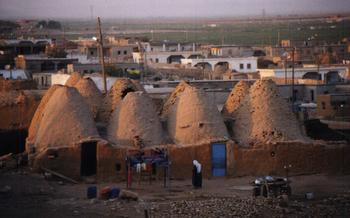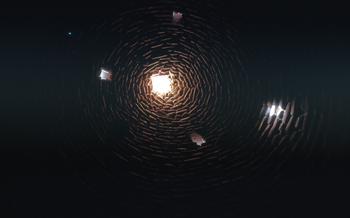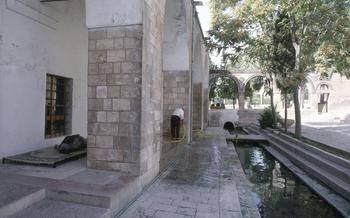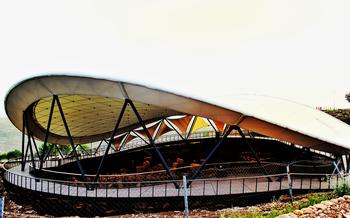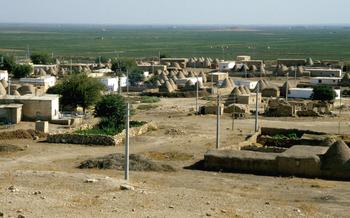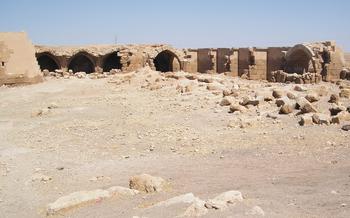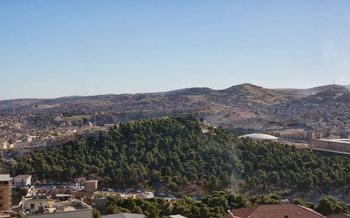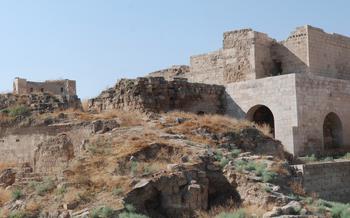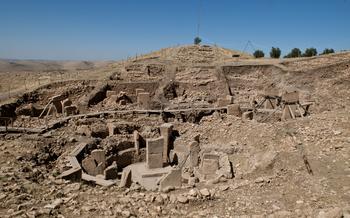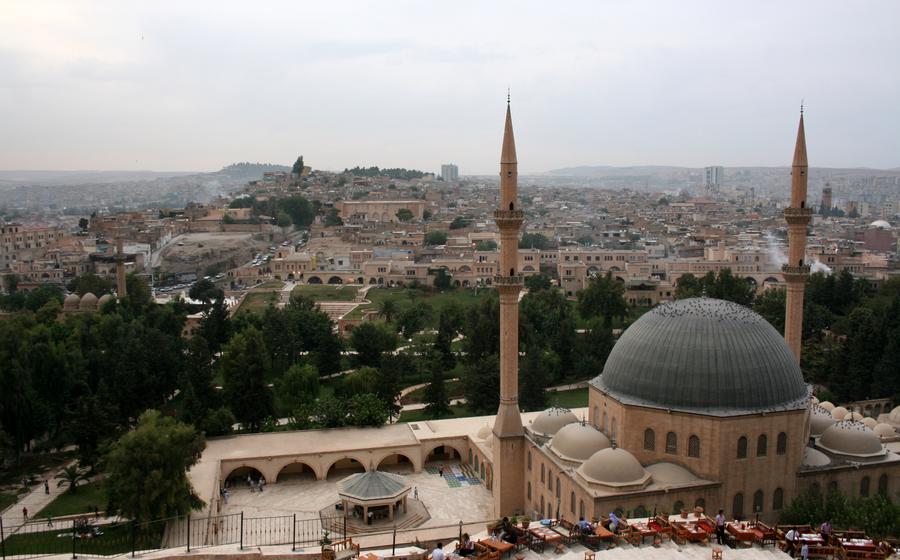
Harran Observatory Ruins
- A Journey to the Stars: Unveiling the Secrets of Harran
- The People of Harran: Guardians of Ancient Knowledge
- A Glimpse into the Past: Exploring the Ruins
- The Observatory's Enduring Legacy
- An Inspiring Destination for History Buffs
- Practical Tips for an Unforgettable Visit
- Transportation: Reaching the Harran Observatory
- Accommodations: Finding Your Home Away from Home
- Dining Delights: Savoring Local Cuisine
- Shopping: Bringing Home a Piece of Harran
- Things to Do Nearby: Exploring Şanlıurfa
- Events and Festivals: Embracing Harran's Cultural Heritage
- Safety Precautions: Ensuring a Smooth Journey
- Photography and Videography: Capturing the Essence of Harran
- Insider Tip: Unveiling the Hidden Gem of Göbekli Tepe
A Journey to the Stars: Unveiling the Secrets of Harran
In the heart of Şanlıurfa, Turkey, lies a testament to human fascination with the cosmos—the Harran Observatory Ruins. This ancient site, dating back to the 7th century BCE, stands as a symbol of Mesopotamia's scientific and cultural achievements. Built by the Babylonians, Harran served as a center for astronomical observation and played a crucial role in shaping our understanding of the universe.
The Harran Observatory's legacy extends far beyond its physical remains. It was here that astronomers made groundbreaking observations, charting the movements of celestial bodies, eclipses, and planetary conjunctions. Their knowledge formed the basis of early calendars and navigation systems, guiding travelers across vast deserts and oceans.
The architectural design of the observatory reflects the ingenuity of its builders. Constructed from local basalt rock, the complex features a unique arrangement of towers, courtyards, and underground chambers. These structures were strategically aligned with astronomical events, allowing astronomers to precisely track the positions of celestial objects.
The Harran Observatory also holds deep cultural and religious significance. The city of Harran was once a major center of the Sabian religion, whose followers revered the stars and planets as divine beings. The observatory served as a sacred place, where Sabian priests performed rituals and ceremonies to honor the celestial bodies.
The People of Harran: Guardians of Ancient Knowledge
The people of Harran, who reside near the observatory, are renowned for their unique cultural heritage, deeply rooted in the region's ancient history and astronomical traditions. Local legends passed down through generations intertwine with scientific knowledge, creating a fascinating narrative. They believe that the stars hold the secrets to their destiny and guide their lives.
Traditions and customs have been preserved and celebrated, reflecting their deep connection to the cosmos. One notable tradition is the annual stargazing festival, where families gather to observe the night sky, sharing stories and insights about constellations and celestial events. This festival showcases the continuity of astronomical knowledge within the Harran community.
Throughout history, the people of Harran have made significant contributions to astronomy. They were renowned observers and mathematicians, developing techniques for tracking celestial bodies and predicting their movements. Their expertise was sought after by scholars from across the region, and their observations influenced the development of astronomy in the Islamic world.
In recent years, the Harran community has undertaken initiatives to preserve and promote their astronomical heritage. They have established cultural centers and educational programs to raise awareness about the observatory and its significance. By sharing their knowledge and traditions, they aim to inspire future generations to explore the mysteries of the universe.
A Glimpse into the Past: Exploring the Ruins
Excavations at the Harran Observatory Ruins have uncovered a wealth of fascinating structures and artifacts. The site consists of a main building, known as the "Observatory Tower," which was used for astronomical observations. This tower is surrounded by smaller structures, including workshops, living quarters, and storage rooms.
The Observatory Tower is an impressive sight, standing over 20 meters tall. It is constructed from large blocks of limestone and features a series of windows and openings that were used to observe the stars. Inside the tower, archaeologists have discovered a number of artifacts, including stone tablets inscribed with astronomical calculations, as well as bronze and iron tools used for making observations.
In addition to the Observatory Tower, the ruins also include a number of other structures, such as a mosque, a bathhouse, and a caravanserai. These structures provide evidence of the many different uses that the Harran Observatory served throughout its history. The mosque, for example, suggests that the observatory was also a center of religious learning, while the bathhouse and caravanserai indicate that it was a place of rest and refreshment for travelers.
The Harran Observatory Ruins are a valuable source of information about the history of astronomy and the development of scientific thought in the ancient world. The excavations have revealed a complex and sophisticated society that was deeply engaged in the study of the stars. The ruins are a testament to the ingenuity and perseverance of the people of Harran, who made significant contributions to our understanding of the universe.
The Observatory's Enduring Legacy
The Harran Observatory has left an indelible mark on the course of human history, influencing civilizations across the globe. Its contributions to astronomy and mathematics have played a pivotal role in shaping our understanding of the universe. The observatory's groundbreaking work in celestial observation laid the groundwork for modern astronomy, providing invaluable insights into the movements of planets, stars, and constellations.
The observatory's legacy extends far beyond its scientific achievements. It served as a beacon of knowledge and learning, attracting scholars and astronomers from distant lands who sought to unravel the mysteries of the cosmos. The observatory's reputation as a center of intellectual pursuit contributed to the region's cultural and economic prosperity, fostering an environment of innovation and discovery.
In recognition of its exceptional historical and cultural significance, the Harran Observatory was designated as a UNESCO World Heritage Site in 201This prestigious designation serves as a testament to the observatory's enduring impact and its status as a cherished heritage site that must be preserved for future generations.
To this day, the Harran Observatory continues to inspire awe and wonder in visitors from around the world. Its ruins stand as a reminder of the ingenuity and dedication of our ancestors, who dared to gaze up at the stars and seek answers to the fundamental questions of our existence.
An Inspiring Destination for History Buffs
The Harran Observatory is not just a historical site but also an inspiring destination for history buffs and archaeology enthusiasts. It offers a unique opportunity to learn about ancient civilizations, astronomy, and the development of scientific thought. Visitors can engage in educational programs, attend cultural festivals and events, and explore interactive displays and exhibits that bring the past to life. On-site guides and interpreters are available to provide insights into the history and significance of the site, making the experience even more enriching. Whether you're a seasoned historian or simply curious about the wonders of the ancient world, the Harran Observatory promises an unforgettable journey through time.
Practical Tips for an Unforgettable Visit
To make the most of your visit to the Harran Observatory ruins, careful planning is essential.
Firstly, the best time to visit is during the shoulder seasons (April-May and September-October) when the weather is pleasant and the crowds are smaller.
When it comes to dress code and cultural considerations, it's important to respect local customs by dressing modestly and avoiding revealing clothing. Remember to be respectful and mindful of local cultural norms, particularly if visiting during religious holidays or events.
The site is generally accessible for visitors, with paved pathways and ramps for wheelchairs. However, it's advisable to bring comfortable shoes as you'll be doing a fair amount of walking on uneven terrain. Basic facilities like restrooms and a small café are available on-site for your convenience.
Tour options are available to enhance your experience. Guided tours provide valuable insights into the history and significance of the site. You can opt for a half-day or full-day tour, depending on your interests and time constraints.
Duration: Plan to spend at least two to three hours exploring the ruins at a leisurely pace. This will give you ample time to admire the architecture, read the information panels, and take plenty of photos.
Transportation: Reaching the Harran Observatory
Reaching the Harran Observatory requires a bit of planning, as it is located about 45 kilometers southeast of Şanlıurfa city center. While public transportation options are limited, there are various ways to get to the site.
From Şanlıurfa City Center: - Taxis: The most convenient option is to take a taxi from the city center. Taxis are readily available and can be negotiated for a round-trip fare. - Hire a Car: Renting a car offers flexibility and allows you to explore the region at your own pace. Several car rental agencies operate in Şanlıurfa, providing a range of vehicles to suit your needs.
From Other Turkish Cities: - Intercity Buses: If you're coming from another city in Turkey, intercity buses offer a budget-friendly option. Buses depart from major cities like Ankara, Istanbul, and Izmir directly to Şanlıurfa. From there, you can take a taxi or rent a car to reach the observatory. - Domestic Flights: Şanlıurfa has a domestic airport with flights from major cities within Turkey. Once at the airport, you can arrange for a transfer to the observatory through a local tour operator or by renting a car.
International Connections: - International Flights: Şanlıurfa does not have direct international flights, so you'll need to connect through Istanbul or another major Turkish city. From there, you can take a domestic flight or bus to Şanlıurfa.
Car Rental and Public Transit Options: - Car Rental: Renting a car is recommended if you want the freedom to explore the region at your own pace. Several international and local car rental companies operate in Şanlıurfa. - Public Transit: Public transportation to the Harran Observatory is limited. However, you can take a local bus from Şanlıurfa city center to the town of Harran and then transfer to a shared taxi or arrange for a private transfer to the observatory.
Accommodations: Finding Your Home Away from Home
When planning your trip to the Harran Observatory, finding suitable accommodations is essential. The area offers a range of options, catering to different budgets and preferences.
-
Nearby Hotels and Guesthouses: For a comfortable stay, consider hotels or guesthouses in the vicinity of the observatory. These establishments provide modern amenities and convenient access to the site.
-
Camping Facilities: Camping enthusiasts can pitch their tents at designated campsites near the observatory. This option offers a unique experience under the starry sky, allowing visitors to immerse themselves fully in the site's ambiance.
-
Local Homestays and Cultural Experiences: To delve deeper into Harran's culture, opt for a homestay with local families. This immersive experience provides an opportunity to learn about traditional customs, sample authentic cuisine, and gain insights into the local way of life.
-
Recommendations for Budget and Luxury Stays: For budget-conscious travelers, there are affordable options available, including hostels and guesthouses. For a luxurious stay, consider boutique hotels or private villas that offer exclusive amenities and personalized services.
Dining Delights: Savoring Local Cuisine
A journey to Harran is incomplete without indulging in the delectable local cuisine that has been shaped by centuries of history and tradition. The region is renowned for its unique dishes that showcase the flavors of the Middle East. Here are some must-try culinary experiences:
-
Must-Try Harran Dishes:
-
Şıllık: A traditional lamb stew cooked in a clay pot, seasoned with local spices and served with flatbread.
-
Firik Pilaf: A flavorful pilaf made with roasted wheat, vegetables, and herbs, offering a nutty and aromatic taste.
-
Çiğ Köfte: A raw meatball dish made with bulgur, spices, and herbs, known for its bold and tangy flavor.
-
Lahmacun: A thin, crispy flatbread topped with minced meat, vegetables, and spices, similar to Turkish pizza.
-
Katmer: A flaky pastry filled with cheese, nuts, and honey, a popular dessert in the region.
-
Must-Visit Restaurants and Cafés:
-
Sofrası: A traditional Turkish restaurant offering a wide range of local dishes, including Şıllık, Firik Pilaf, and Lahmacun.
-
Çiğ Köfteci Ali Usta: A local favorite for Çiğ Köfte, known for its authentic recipe and generous portions.
-
Katmerci Zeki Usta: A renowned pastry shop specializing in Katmer, offering a variety of flavors and toppings.
-
Markets and Street Food Stalls:
-
Harran Bazaar: A vibrant marketplace where you can find fresh produce, local spices, and street food stalls selling traditional Turkish delights.
-
Gümrük Han: A historic caravanserai transformed into a cultural center, featuring food stalls, cafés, and shops selling local handicrafts.
-
Tips for Vegetarians and Vegans:
-
While Harran cuisine is predominantly meat-based, there are vegetarian options available. Look for dishes made with vegetables, legumes, and grains.
-
Ask about vegetarian options at restaurants, as some may be able to accommodate special requests.
-
Explore the local markets for fresh fruits, vegetables, and nuts to create your own vegetarian meals.
Shopping: Bringing Home a Piece of Harran
Exploring the local markets and shops in Harran is a delightful experience, offering a unique opportunity to take home a piece of this ancient city's rich cultural heritage. From intricate handicrafts to exquisite pottery and ceramics, the vibrant bazaars showcase the artistry and craftsmanship of the local community.
One of the must-have souvenirs from Harran is its renowned pottery. Renowned for its unique designs and intricate patterns, each piece is a testament to the skills and creativity of local artisans. Visitors can choose from a wide variety of pottery items, including decorative plates, vases, and bowls, all adorned with vibrant colors and traditional motifs.
Another popular souvenir from Harran is its traditional textiles and rugs. Handcrafted by local weavers using ancient techniques, these textiles showcase the region's rich weaving traditions. From intricately patterned carpets to vibrant shawls and scarves, shoppers can find a wide range of textiles to suit their tastes and preferences.
When shopping in Harran, it's important to embrace the local customs and traditions. Bargaining is a common practice, and visitors are encouraged to engage in friendly negotiations with the vendors. However, it's essential to be respectful and mindful of local customs and etiquette, ensuring a positive shopping experience for both buyers and sellers.
Whether you're looking for unique handicrafts, exquisite pottery, or traditional textiles, the markets and shops of Harran offer a treasure trove of authentic souvenirs to cherish. Embrace the vibrant atmosphere, engage with the friendly locals, and take home a piece of Harran's rich cultural heritage to remember your visit for years to come.
Things to Do Nearby: Exploring Şanlıurfa
Beyond the Harran Observatory, Şanlıurfa offers a wealth of historical, natural, and cultural attractions. History buffs can delve into the past at the Şanlıurfa Museum, showcasing artifacts from various civilizations that called the region home. The city is also dotted with ancient mosques, churches, and madrasahs, each with unique architectural features and historical significance.
Nature enthusiasts will find solace in the lush green spaces of Şanlıurfa. The city's parks, gardens, and nearby countryside offer opportunities for relaxation and exploration. Take a leisurely stroll along the banks of the Balıklıgöl (Fish Lake), teeming with sacred carp and a symbol of the city's rich cultural heritage.
Şanlıurfa's cuisine is a delight for foodies, with traditional dishes that blend Turkish, Arab, and Kurdish influences. Savor the flavors of grilled kebabs, stuffed grape leaves, and the region's famous çiğ köfte, a spicy raw meat dish. Local markets and street food stalls offer a vibrant culinary experience, where visitors can indulge in fresh produce, traditional sweets, and aromatic spices.
Plan a day trip to nearby Harran, a historical town renowned for its unique beehive-shaped houses and ancient city walls. Immerse yourself in the local culture and traditions, visit the Harran Museum, and explore the ruins of the ancient Harran University, once a renowned center of learning.
Şanlıurfa serves as an excellent base for exploring the surrounding region. Take a scenic drive to Mount Nemrut, a UNESCO World Heritage Site, and marvel at the colossal statues of ancient gods that adorn its peak. Discover the hidden wonders of Göbekli Tepe, the world's oldest known temple, located just a short distance from Şanlıurfa. This enigmatic site, dating back to the 10th millennium BC, offers a glimpse into the origins of human civilization.
Events and Festivals: Embracing Harran's Cultural Heritage
Harran's rich cultural heritage comes alive during its annual events and festivals. The Harran Culture Festival, held in summer, is a vibrant celebration showcasing traditional music, dance, handicrafts, and local cuisine. Visitors can immerse themselves in the city's vibrant atmosphere, witness captivating performances, and savor delectable local dishes.
Seasonal celebrations and traditions are deeply ingrained in Harran's identity. The New Year's Festival in March welcomes the spring equinox with joyous festivities, while the Harvest Festival in October honors the bounty of the earth and celebrates the agricultural heritage of the region.
Local music and dance performances are an integral part of Harran's cultural scene. Visitors can enjoy mesmerizing traditional dance troupes and live music concerts featuring local musicians playing soulful melodies on traditional instruments.
To fully immerse themselves in the local culture, visitors are encouraged to join in on community gatherings such as weddings, religious ceremonies, and festivals. These events offer a unique opportunity to interact with the friendly locals, learn about their customs, and experience the warmth and hospitality of the Harran community.
Safety Precautions: Ensuring a Smooth Journey
When embarking on any journey, safety should be a top priority. Here are some essential precautions to keep in mind for a smooth and enjoyable experience in Harran:
- General Safety Tips for Travelers:
- Be aware of your surroundings, especially in crowded areas.
- Keep your valuables secure and avoid carrying large sums of money.
- Learn a few basic Turkish phrases for effective communication.
-
Respect local customs and traditions to avoid misunderstandings.
-
Specific Considerations for Solo Travelers:
- Inform your accommodation or a trusted friend about your plans.
- Avoid venturing out alone at night and stick to well-lit areas.
-
Consider joining group tours or activities for added safety.
-
Avoiding Common Tourist Traps and Scams:
- Be wary of individuals offering unsolicited services or tours.
- Compare prices and services from different vendors before making purchases.
-
Be skeptical of overly friendly strangers seeking personal information.
-
Local Emergency Contacts and Resources:
- Familiarize yourself with local emergency numbers and the nearest hospital.
- Keep a copy of your passport and visa in a safe place.
- In case of any concerns or emergencies, seek assistance from your hotel staff or local authorities.
Photography and Videography: Capturing the Essence of Harran
The Harran Observatory is a treasure trove for photographers and videographers, offering a unique blend of natural beauty and historical significance. Capturing the essence of this ancient site requires careful planning and consideration.
Permits and Regulations for Photography:
Obtaining the necessary permits for photography and videography is essential. Contact local authorities or the Şanlıurfa Museum for specific guidelines and regulations. Please respect these regulations to preserve the site's integrity and avoid any inconveniences.
Ideal Times for Stunning Shots:
The best time to capture the observatory's beauty is during sunrise or sunset, when the warm hues of the sky illuminate the ruins and create a magical atmosphere. Night photography enthusiasts can marvel at the star-studded sky above the ancient structures, offering breathtaking shots of the heavens.
Tips for Taking Panoramic and Close-up Photos:
To capture the vastness of the site, use a wide-angle lens for panoramic shots. For more intimate and detailed images, switch to a telephoto lens to zoom in on specific architectural features, artifacts, or inscriptions. Experiment with different angles and perspectives to create visually compelling compositions.
Respecting Local Customs and Privacy:
Remember that the Harran Observatory is a sacred site for many people. Be respectful of local customs and traditions, and avoid disturbing ongoing religious practices or ceremonies. Ask permission before photographing individuals, and always treat the local community with kindness and understanding.
Insider Tip: Unveiling the Hidden Gem of Göbekli Tepe
Beyond the wonders of Harran, travelers seeking an even deeper journey into antiquity should not miss the chance to visit Göbekli Tepe, located approximately 55 kilometers northeast. This enigmatic site, discovered in the 1990s, has captured the attention of archaeologists and history buffs worldwide.
Göbekli Tepe is believed to be the world's oldest known temple, dating back to around 9000 BC. Its intricate carvings and massive stone structures have challenged our understanding of early human civilization and religious practices. The site consists of several circular enclosures, each adorned with T-shaped pillars featuring animal reliefs and abstract symbols.
While Göbekli Tepe remains under excavation, visitors can explore the site's excavated areas and gain insights into the lives of our prehistoric ancestors. Guided tours are available, providing valuable context and explanations of the ongoing research.
To reach Göbekli Tepe, travelers can take a day trip from Şanlıurfa or Harran. Public transportation options are limited, so renting a car or joining an organized tour is recommended. The drive offers stunning views of the surrounding countryside.
Combining a visit to Harran and Göbekli Tepe creates a truly immersive journey into the ancient world. These two sites, separated by time but connected by their profound historical significance, offer a unique opportunity to explore the roots of human civilization and marvel at the ingenuity of our ancestors.
